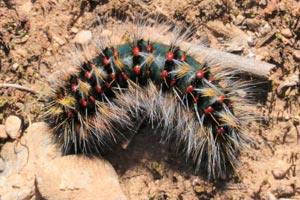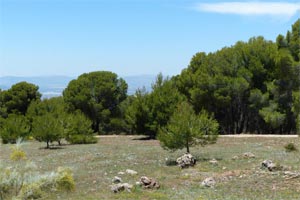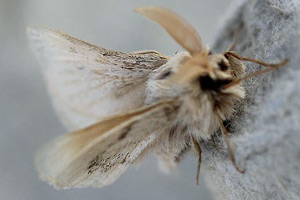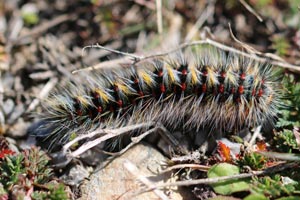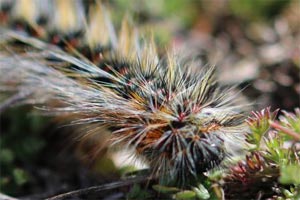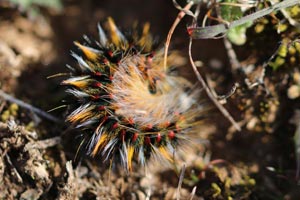

 +1Kontinente:EU
+1Kontinente:EU1. Lebendfotos
1.1. Falter
1.2. Raupe
2. Biologie
2.1. Habitat
2.2. Nahrung der Raupe
- [Poaceae:] Festuca scariosa
- [Scrophulariaceae:] Verbascum giganteum
- [Asphodelaceae:] Asphodelus ramosus (Ästiger Affodill)
- [Geraniaceae:] Erodium sp. (Reiherschnabel)
- [Asteraceae:] Centaurea granatensis
De Freina et al. (2015) schreiben: "Chondrostega escobesae is polyphagous on various low plants. Most of the larvae in the Jabalcuz population were found feeding sheltered into Festuca scariosa (Poaceae). Other low plants the larvae were observed feeding on are Verbascum giganteum (Scrophulariaceae), Asphodelus ramosus (Asphodelaceae), Erodium spp. (Geraniaceae) and Centaurea granatensis (Asteraceae). Die Raupe ist demnach also hochgradig polyphag, was sich dann auch durch weitere, im natürlichen Habitat fehlende Futterpflanzen in der Zucht (Echium plantagineum, Plantago lanceolata, Plantago lagopus, Punica granatum, Populus spp., Lactuca virosa, mehrere andere Süßgräser) bestätigt hat.
3. Weitere Informationen
3.1. Etymologie (Namenserklärung)
De Freina et al. (2015) lassen wissen: „The patronym acknowledges the merits of Ruth Escobés Jiménez, Logroño, for her entomological commitment in the documentation and conservation of Spanish Lepidoptera, as well as her help in the study of this new species over many years."
3.2. Taxonomie
De Freina et al. (2015) studieren spanische Populationen der Gattung Chondrostega und stellen dabei fest, dass sich die Populationen Andalusiens hinsichtlich der Färbung ausgewachsener Raupen deutlich von den Tieren von Chondrostega vandalicia Zentral- und Nord-Spanien unterscheiden. Hinzu kommen kleinere Unterschiede in den männlichen Genitalien und in der Hinterflügelzeichnung. Beim Barcoding (Untersuchung COI) wird festgestellt, dass sich die Taxa um mindestens 3,8 % unterscheiden. Sie werden daher als allopatrisch getrennte Arten geführt und die Sippe Andalusiens als Art neu beschrieben.
(Autor: Erwin Rennwald)
3.3. Typenmaterial
De Freina et al. (2015) schreiben zum Holotypus: "♂, Andalucía, Málaga (Ronda), Sierra de las Nieves, Puerto de los Pilones, 1750 m, UTM 30S UF16, 5.IX.2014, C. Antonietty leg. (CFM; MWM/ZSM, BC DNA-N° IBEB 14V507; Figs 1, 2)." Hinzu kommen 10 Paratypen (alles ♂♂) vom selben Fundort und 2 Paratypen (je 1 ♂ und ♀) von Andalucía, Jaén, Pico Jabalcuz, Los Villares.
3.4. Literatur
- Erstbeschreibung: de Freina, J. J., Monasterio León, Y., Antonietty, C. A. & R. Vila (2015): Notes on the biology, distribution and taxonomy of Chondrostega Lederer, 1857 in the Iberian Peninsula with a description of the southern Spanish Chondrostega escobesae sp. nov. (Lepidoptera: Lasiocampidae, Chondrosteginae). — Entomologische Zeitschrift 125 (4): 195-207. Schwanfeld.



